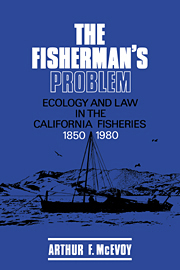Book contents
- Frontmatter
- Contents
- List of figures
- List of tables
- Preface
- Acknowledgments
- List of abbreviations
- Introduction
- I The miner's canary
- II Sun, wind, and sail, 1850–1910
- III The industrial frontier, 1910–1950
- IV Enclosure of the ocean, 1950–1980
- 8 Gridlock
- 9 Something of a vacuum
- 10 Leaving fish in the ocean
- Conclusion
- Appendixes
- Notes
- Selected bibliography
- Index
8 - Gridlock
Published online by Cambridge University Press: 06 January 2010
- Frontmatter
- Contents
- List of figures
- List of tables
- Preface
- Acknowledgments
- List of abbreviations
- Introduction
- I The miner's canary
- II Sun, wind, and sail, 1850–1910
- III The industrial frontier, 1910–1950
- IV Enclosure of the ocean, 1950–1980
- 8 Gridlock
- 9 Something of a vacuum
- 10 Leaving fish in the ocean
- Conclusion
- Appendixes
- Notes
- Selected bibliography
- Index
Summary
The canneries themselves fought the war by getting the limit taken off fish and catching them all. It was done for patriotic reasons but that didn't bring the fish back. … It was the same noble impulse that stripped the forests of the West and right now is pumping water out of California's earth faster than it can rain back in. When the desert comes people will be sad; just as Cannery Row was sad when all the pilchards were caught and canned and eaten.
– John Steinbeck, Sweet Thursday (1954)If electric power, internal combustion, and organic chemistry opened a new economic frontier at the turn of the twentieth century, the end of World War II signaled its impending close. Expansion continued during the postwar era, to be sure. Frontier ideology and frontier imagery continued to color people's thinking about the nature and future of American society. But there were signs at the end of the war that even the modern industrial world had finite limits, and the ensuing quarter-century seemed to bear them out.
The atomic bomb not only gave people the power to eradicate civilization as they knew it but, as radioactive fallout began making its way through the environment into commercial dairy products during the early 1960s, gave tangible proof of the ecological links among people, other living things, and the environment. Synthetic pesticides and antibiotics, likewise, promised at first to exterminate “enemy” insects and bacteria but, as those organisms grew resistant to the changing chemistry of their environment, once again taught people that nature was a living thing in which their lives were embedded and not merely the passive object of technological manipulation.
- Type
- Chapter
- Information
- The Fisherman's ProblemEcology and Law in the California Fisheries, 1850–1980, pp. 187 - 206Publisher: Cambridge University PressPrint publication year: 1986

